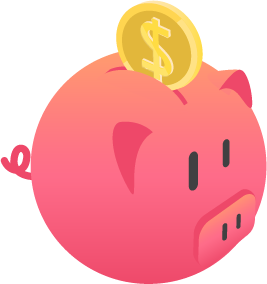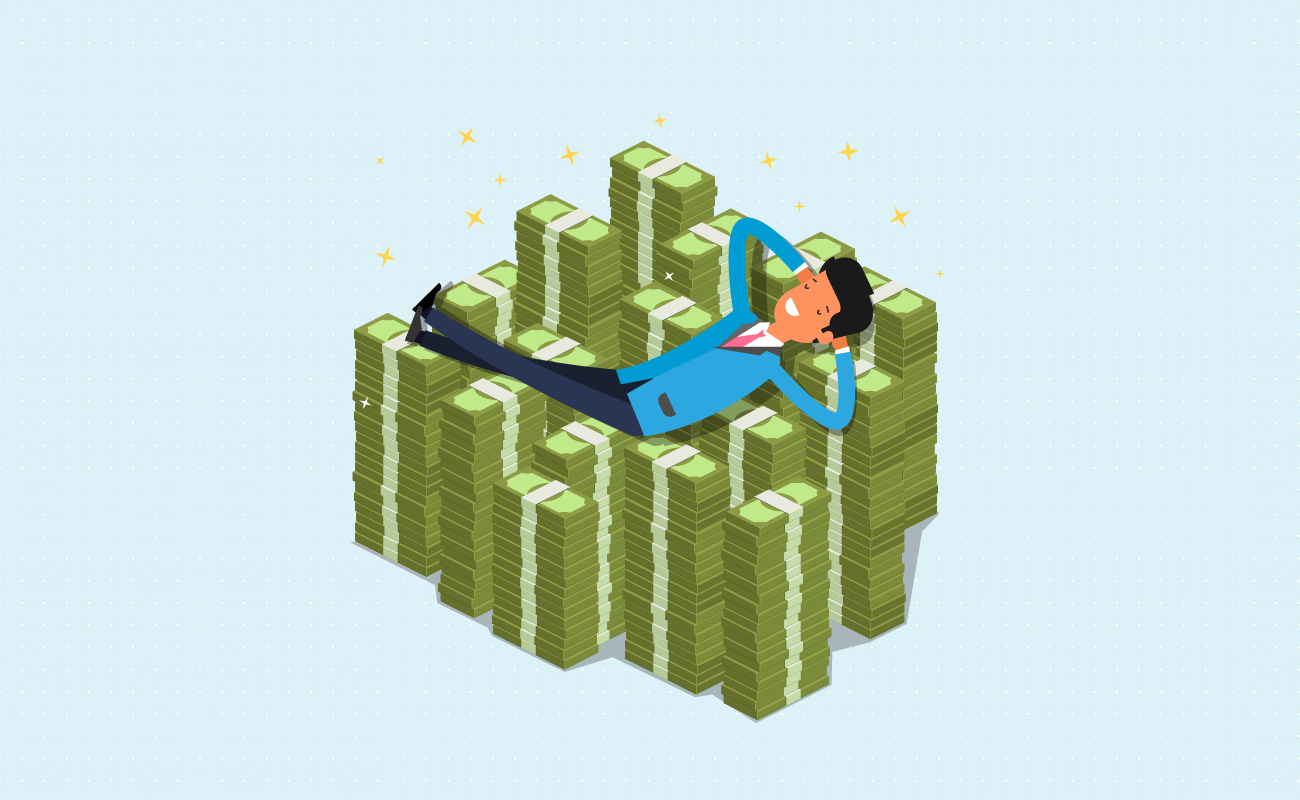Savings Goals
Net Worth
 Future Value Calculator
Future Value CalculatorThis calculator makes it easy to estimate the future value of a one-time investment in an ordinary savings account, CD,or other financial instrument. Enter you initial investment, the anticipated annual rate of return & how long you will allow the investment to grow.
Guide published by Jose Abuyuan on November 9, 2020

There’s more to wealth-building than storing money. Even if you’ve managed to hide away $500 in a piggy bank, it won’t do much good if it stays there. To grow savings, your money needs to work. In time, the $500 you put in a savings account or an investment portfolio will be worth much more. You can rely on your rates of return to give you a picture of how much your money might grow over time.
Understanding money’s future value plays a key role in long-term financial planning. By knowing how much you can earn, you can make informed decisions on where you should invest your money to increase your income.

Time is money. This is a statement that rings true no matter how you look at it. For most people, it means that their time has value and shouldn’t be wasted. Putting your time to good use can either save or make you money. Those hours shaved off your commute cuts your fuel expenses and gets you to work early. That’s money saved and money earned. It also means that you shouldn’t give your time away for free without a good reason.
You can also take this literally. Money, when put to work, will increase with time. Even putting your money in a savings account helps build your wealth little by little. Investing in stocks and bonds, meanwhile, can build your wealth over the course of several years. All you need is to keep your money in place and wait.
Even simple investments link up to form a chain that keeps the economy rolling. People put their money in banks for safekeeping and receive interest as payment. These same banks use that money to fund business loans and mortgages. They receive payments plus interest from entrepreneurs and mortgages. In turn, the bank pays you interest. In each of these stages, your money is at work, building businesses and home equity, while paying you back. The key to making this cycle work is time.
All investing is a variation on one theme. An investment is, in essence, a loan given to a business or personal venture. In this picture, you are the lender and you gain interest. As recompense, the people you entrust with your money must pay you a fee (the interest). How much interest you make will depend on three major factors:
The larger any of these factors are, the greater the amount of interest you earn. For investors, term and rate are the most important factors. If you are a starting investor, for instance, you don’t always have a lot of money to invest right away. However, you can bet on time horizons and generous rates of return to build wealth for you. Longer terms also help you hedge against the risks you might face. We’ll get into those details later.
The calculation for interest varies. For some, such as amortized loans, the term is fixed. Eventually, the borrower will pay back the loan plus interest in a set number of years. For savings accounts and other investments, the term is indefinite. You keep earning interest as long as you keep your money invested.

Future value is made possible through compound interest. It is the investor’s greatest ally. Compound interest is, in essence, interest on interest. Your investment’s term is divided into compounding periods where the money earns interest. These intervals can be anywhere from once a month to once a year. Interest earned from each interval is added to your principal.
Compound interest builds on the mathematical concept of exponential growth. Your principal is not a constant. It grows with every compounding period even as your rate remains the same. Thus, each new interest payment is higher than the last. That is, of course, if you left it alone.
Founding father and polymath Benjamin Franklin put it best:
“Money makes money. And the money that money makes, makes money.”
Compounding hinges on reinvestment. To achieve steady exponential growth, your principal must remain untouched. Take away money, and you lower your principal and thus, your earnings. Meanwhile, if you keep depositing money, your interest earnings grow even faster.
Exponential growth through compound interest fascinated Benjamin Franklin. Nearing the end of his life, he sought to use it for the common good. In his will, he left the cities of Philadelphia and Boston a self-perpetuating philanthropic fund worth £1,000. In 2008, that starting principal would’ve been worth $100,000. He calculated that fund with great detail for the next 200 years.
He also left strict instructions on how the cities would use it. After a century, the cities may use a part of the fund for civic projects while leaving behind principal. They must then reinvest principal for another century, rinse and repeat. The fund itself wasn’t as profitable as envisioned. The cities could not maintain the projected five percent rate needed to keep the fund on track. The money it did make, however, found good use. Proceeds from Ben’s fund paid for ambitious civic projects like Boston’s Franklin Park.

When you invest your money, you can expect it to grow to a specific amount at a later date. This future value is the nominal value your money will have down the line. The value your money has today, in contrast, is known as present value. The growth of your investment’s future value derives from the rate of return. The larger your rate, the greater your future value will be.
Future value is measured in periods, the span of time between the present and future. A period can be any unit of time, but is usually a year or a month. Single-period investments take place in one period, usually around the span of a year. Multi-period investments, discussed here, take place over several periods. These investments often earn compound interest.
The basic formula for future value using compound interest is as follows:
FV = PV x (1 + i)t
Where:
FV = Future value
PV = Present value
i = Interest rate
t = Number of periods
In most cases, the interest rate is annual. To find out the future gains for investments that compound monthly (such as savings accounts), simply divide the interest rate by twelve.
Let’s see this in action. We’ll assume that you make a one-time deposit of $30,000 to an investment fund. Your portfolio’s projected annual percentage yield (APY) is about 8 percent and compounds each year. You leave that money for 10 years. Here’s how much your future value would be:
Principal (Present Value): $30,000
Rate (APY): 8%
Term: 10 years (compounds annually)
= $30,000 x (1 + 0.08) ^ 10
= $30,000 x 2.1589
= $64,767.75
In a decade, the one-time $30,000 you invested would be worth $64,767.75. That’s more than twice the amount you started with! But wait, there’s a catch. You also owe taxes to these earnings. In addition, you must also contend with eventual inflation.
Money does not keep its worth forever. Over time, it loses its buying power to inflation. This is observed as the prices of goods go up. Although the amount of money you invested grows over time, its true value has gone down. Inflation is all but inevitable, but the rate it does isn’t always clear cut. In fact, a low yet steady inflation rate is part of a good economic climate. Policymakers have pegged 2 percent as the target rate.
Thus, the nominal worth of your future money isn’t the same as its actual worth today. To truly grow, your money must grow at a rate that outperforms inflation.
Let’s use the calculator above to see future value at work. Using our first example, we’ll assume that you also have a state income tax rate of 5 percent. You also fall under the 12 percent federal income tax bracket. Assuming a healthy inflation rate of 2 percent, here’s where your earnings will stand in a decade’s time:
Income Tax (Federal): 12%
Income Tax (State): 5%
Projected Inflation Rate: 2%
| Category | Value |
|---|---|
| Future Value | $64,767.75 |
| Returns | $34,767.75 |
| Taxes Due | $5,910.52 |
| Savings After Taxes | $58,857.23 |
| Inflation-adjusted Purchasing Power | $48,090.64 |
| Change in Purchasing Power | $18,090.64 |
| Percent Change in Purchasing Power | 60.30% |
Although you’ve made more than twice your principal, inflation means that it has lost some of its value. In ten years, your $58,857.23 would be worth the same as $48,090.64 in today’s money. While still a sizable return, it’s nowhere near as impressive as it seemed on the surface. If you want to bolster your earnings even more, you must plan around taxes and inflation.
To guarantee profit regardless of inflation, you must choose investments with high yields. This isn’t as simple as it sounds. In the world of investing, these always come with high risks. You might lose too much in the short term if you blindly jump into high-stakes investing. Without proper planning, you may go broke before you gain anything.
The problem with most secure investments is that they do not offer high rates of return. Even the most generous savings account will seldom offer rates higher than 2 percent. To gain wealth, you’ll need to strike the proper balance between risk and reward. Fortune rewards the patient, but favors the bold.
The following chart is based on a comprehensive study from Harvard that charted the nominal and real rates of return in four key asset classes. The study itself outlined the results of more than a century of investing. The data below is for the years 1950 through 2015, a 65-year period:
| Asset Class | Nominal Rate of Return | Real Rate of Return |
|---|---|---|
| Treasury Bills | 5.39% | 0.88% |
| Bonds | 7.30% | 2.79% |
| Equity (Stocks) | 12.97% | 8.30% |
| Housing (Real Estate) | 12.27% | 7.42% |
Money investments (treasury bills and bonds) have the least amount of risks. They also perform the worst in the long term, adjusted for inflation. But while equity investments provide the biggest returns, they also come with the most risks. The value of stocks fluctuate on a daily basis, but tend to go up over several years. For stock investors, money comes only with time.
Risk management, therefore, is a crucial part of the investing process. Your investments must strike the balance between the gains you expect today and tomorrow. The best way to hedge against these risks is to have a diversified portfolio. This means investing in several types of assets. When one type underperforms, the others pick up the slack.

Risks are endemic to all investments. Exposing yourself to losses is unavoidable when investing. Being too risk-averse is its own risk. You miss out on the gains you don’t make by playing it safe when you don’t need to. You must be prepared to take the risks you can afford to take.
The fears that fan the flames of fiscal conservatism, however, are not unwarranted. Not everyone can face the same amount of risk unscathed. What could be gambling for some is an acceptable risk for others. Thus, you must tailor your asset allocation to match the amount of risks you are comfortable with.
But how do you measure risks? It depends on several factors that affect your financial future. Tradition holds that age is the primary factor. After all, it’s based on sound logic. Most high-yield investments rely on long time horizons to see a profit. Young investors have time on their sides to wait out short-term volatile periods. Older investors, who don’t have a lot of time until retirement, can’t play that waiting game for long.
Another influential factor is financial stability. Not everyone can cope with short-term losses the same way. One study suggests that this might be the primary factor people use to determine their risk tolerance. Young people have fewer savings to invest and can’t risk their money too much. In contrast, adults with well-established careers and plenty of spare savings can invest in risky investments more.
The value of a publicly traded stock is tied to the ability of a company to make money. As a company grows and turns a profit, so does the value of its stocks to its shareholders. If it incurs losses or faces scrutiny due to scandal, its value decreases. The value of a corporation’s stock can fluctuate on a daily, monthly, and even yearly basis. If a company were to close, you lose all your investments. Scary, huh?
Over time, though, a successful company’s stocks will grow in value. A stable corporation’s growth in value can be relied on over several years. This will make even shocking short-term losses irrelevant to your portfolio. As long as you can afford to wait out the storms, the high short-term risks are nothing to worry about.
Over time, your portfolio might not properly match up with your current risk tolerance. As you age and your finances improve, your risk tolerance changes with it. You might find that you’ve under-utilized your portfolio. On occasion, market forces might also work in your favor a bit too well. The larger value of stocks might expose you to needless risks, especially since short-term gains come and go.
In times like these, you might need to re-allocate your assets to optimize your portfolio. This is as simple as buying or selling until the proportions match your preferred risk tolerance. Let’s say you have a portfolio that now comprises 85 percent of its assets in stocks. If your risk tolerance only lets you set aside 70 percent for stocks, this could be a problem. it might be time to buy more bonds or sell excess stocks.
Always approach re-allocation with care. Buying or selling stocks and bonds too soon might have expensive tax consequences. Consult a financial professional on finding tax-efficient ways to re-balance your portfolio.
Chances are, your income will be much lower upon retirement. This might be enough to qualify you for a lower income tax bracket. Thus, another common way to maximize your cash gains is by deferring your taxes. There are two types of tax-deferred investments: traditional individual retirement accounts and 401(k) accounts.
By deferring your savings until then, you only need to pay that lower tax in the future. Your earnings will also be much higher thanks to your larger starting principal. Find out more about the advantages of postponing your taxes by checking our guide on our tax-deferred savings calculator.
There’s an old saying: don’t count your chickens before they hatch. That doesn’t quite apply to investments. Although you can’t predict the future, you can plan around the things you can expect. With a little forward strategy, you can anticipate and maximize the future value of your savings today.
At the heart of all successful investments is time. So the adage goes, the best time to invest your money was yesterday. Today is the next best thing. The money you put to work now will be worth a lot more tomorrow, but only if you let it be. Time, indeed, equals money, so be patient.
But don’t be so eager to prioritize investments first. Perhaps your money is best spent paying down burdensome debts. You might need liquid money to meet your other needs. Only commit money that you don’t plan to spend on long-term investments. Before putting your money elsewhere, it’s best to build a dedicated emergency fund to cover all your bases.
Financial stability is essential to ramping up your investment strategy. Let our savings goal calculator help you on the path to secure your finances.
Jose Abuyuan is a web content writer, fictionist, and digital artist hailing from Las Piñas City. He is a graduate of Communication and Media Studies at San Beda College Alabang, who took his internship in the weekly news magazine the Philippines Graphic. He has authored works professionally for over a decade.